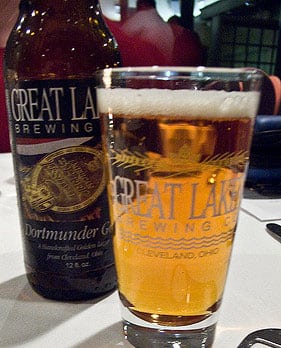
June 23, 2018; Cleveland’s Crain Business
“Growing numbers of US companies are giving workers financial stakes via employee stock ownership plans,” writes Judy Stringer in Cleveland Crain’s Business. Now Great Lakes Brewing Company is poised to join their ranks. Bolstr, a small business crowdfunding site, listed Great Lakes as the number-one craft brewery in Ohio in a 2015 article and described the brewpub as follows:
Great Lakes Brewing Company is the elder statesman of the Ohio brewing community. The brewery opened its doors in 1988 and is the largest of all Ohio breweries. Known for being environmentally friendly and socially responsible, Great Lakes has helped Cleveland draw in new consumers and businesses to the Ohio City neighborhood, which houses the brewery and brewpub. Great Lakes puts a strong emphasis on sustainability, with three main initiatives focused on water stewardship, local foods and farming and waste opportunities.
In short, the fact that the 245-employee company is transitioning to employee ownership attracts notice in Cleveland. According to Great Lakes CEO Bill Boor, by the end of 2019, writes Stringer, “each and every one the 245 employees—regardless of hours worked, wages earned or years of seniority—will get a stake in the Ohio City brewery.”
“This is something the owners Pat and Dan Conway have been contemplating for literally 10 years,” observes Boor. “Now was the right time with the convergence of the anniversary and a lot of thought over time about how they should really share ownership with the employees who they have always cared so much about.”
As Stringer notes, Great Lakes is “part of a gradual, but steady, rise in the number of US companies that provide their workforce with an ownership interest through an Employee Stock Ownership Plan or ESOP, often at no upfront cost to the employees. Between 2010 and 2015, the most recent year for which data is available, an average of 229 new ESOPs were created each year, according to the National Center for Employee Ownership (NCEO). As of 2015, there were 6,669 ESOPs in the U.S., holding total assets of nearly $1.3 trillion.”
Stringer adds that a full 32 percent of those companies are located in the Midwest. Ohio has 290 of these. Roy Messing, director of the Ohio Employee Ownership Center at Kent State University—a place that has provided technical assistance for conversions to employee ownership since its founding in 1987, notes that other conversions in Ohio to employee ownership over the past two years include grocer Buehler Fresh Foods; outdoor product distributor Outtech Inc. in Aurora; Fin Feather Fur, based in Ashland; and the Woodmere consulting firm MarshBerry.
A more venerable employee-owned firm in Ohio is Davey Tree, which is the largest Ohio-based employee-owned company and the 13th largest company nationwide on the NCEO’s ESOP ranking. The firm, which became employee-owned in 1979, has an estimated 9,000 employee-owners.
Sign up for our free newsletters
Subscribe to NPQ's newsletters to have our top stories delivered directly to your inbox.
By signing up, you agree to our privacy policy and terms of use, and to receive messages from NPQ and our partners.
Messing says interest in employee ownership is rising. “General inquiries into ESOPs received by the OEOC have increased by at least 25 percent over the past few years,” Messing observes.
A key driver of the surge in interest is one that NPQ has covered—namely, the aging of baby boomer business owners, or what is sometimes called a silver tsunami. Both Messing and Phillip DeDominicis, managing director of investment banking at California-based ESOP administrator Menke & Associates Inc., concur. Menke & Associates’ presence in the field is significant. Stringer estimates that the firm “creates roughly one in every five new ESOPs.”
“If you look at privately held businesses and who owns them, it’s a lot of 50-year-olds and 60-year-olds,” says DeDominicis. “They own these valuable businesses and they need a market for them somewhere.… But, the reality is many, maybe even most, privately owned businesses are not salable, and certainly not salable at a reasonable price.”
“The ESOP is a shareholder,” DeDominicis adds. “It creates liquidity often at the same if not a better price point.”
Stringer notes that the ESOP route has other advantages, pointing to Messing, who says, “In many cases, contributions of stock and cash to an ESOP are tax deductible, generating additional cash flow that could be reinvested in the business. In addition, for most sellers in a C corporation, the sale of stock to an ESOP can be structured to defer capital gains taxes, while in most instances for S corporations, the percentage of ownership held by the ESOP is not be subject to income tax.”
Transferring ownership to employees also allows longtime owners to remain at the company and maintain some level involvement while gradually cashing in, notes DeDominicis.
“Local ESOP companies, however, say their biggest motivator was ability to reward and incentivize employees,” Stringer adds.
Sandra Reid, a vice president at Davey Tree, says employee ownership helps attract and retain workers. “We know that when we are talking with new recruits, particularly in our industry, that employee ownership is unique,” Reid says. “Whether you are a trimmer in the field, an office support person in a satellite office or a mechanic in one of our shops—anyone has the ability to participate in our employee ownership program, and that is something we are very proud of talking about because we know it sets us apart.”—Steve Dubb













